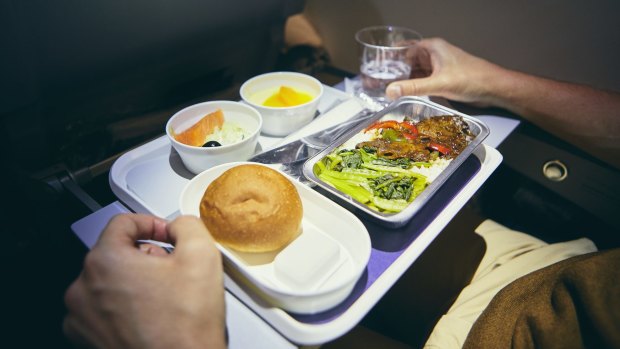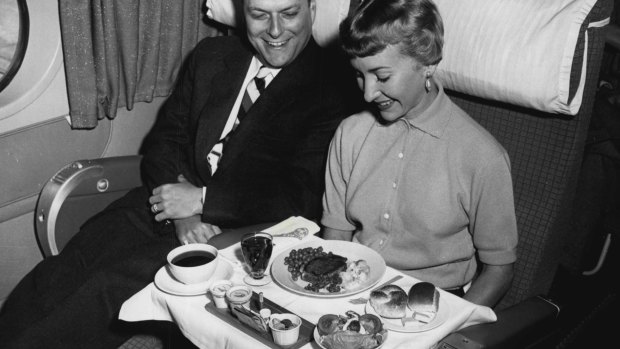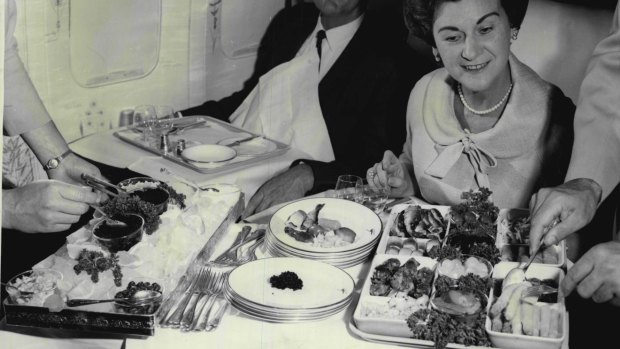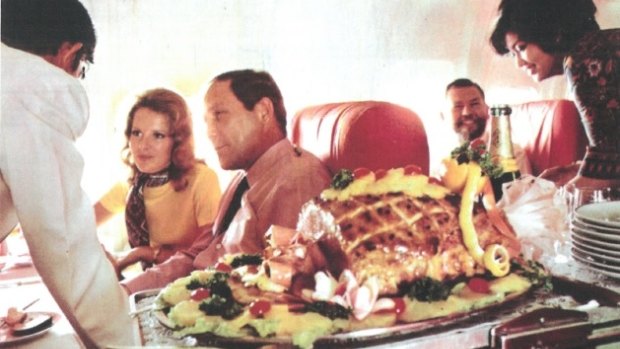This was published 4 years ago
Plane meals: Why eating on planes is close to torture
By Greg Dickinson

Airline meal service is a nightmarish process.Credit: iStock
Hyperbole makes for poor journalism. But I'm going to stick my neck out and say that the way we eat on planes is one morsel of unspreadable butter away from fully-fledged torture. An international airspace emergency, if you will.
Before you roll your eyes, scroll to the bottom of the page and write "pfft, heard this one before" in the comments, this isn't a complaint about the quality of plane food. Dry bread rolls, dry chicken; dry article. Such observations would look outdated in a Jason Manford comedy routine.
Not least because plane food has actually become (marginally) better over the years, as airlines employ celebrity chefs to curate their menus. Heston Blumenthal was recruited by British Airways back in 2011, Singapore Airlines got Gordon Ramsay on board years ago. Neil Perry works with Qantas and Luke Mangan with Virgin Australia. Air France once enlisted Joel Robuchon to do his magic on its menu.

It was in the '40s when everything fell apart for airline meals.Credit: Pan American World Airways
No, what I'm talking about is the nightmarish process of how we are served meals on a plane, and the vessels in which our food is served. The whole experience is awful for the passenger and even worse for the environment. How did we get here?
It is exactly 100 years since the first plane meal was served, on a Handley-Page flight from London to Paris. Back then, selections included cold fried chicken, freshly made sandwiches and fruit salads – all served up in wicker baskets. All sounds rather dignified, doesn't it? No peeling back searing hot tin foil in those days.
Possibly the heyday of the plane meal was in the '30s when, according to airline culinary historian Richard Foss: "Sometimes planes would even stop off for lunch, serving customers in the airline hangar or at picnic tables while the plane refuelled before continuing with the remainder of the trip." Who wouldn't take a civilised two-hour layover over today's mid-air feeding horrorshow?

A more civilised age: Qantas meal service in 1967.Credit: Fairfax Media
But it was in the '40s when everything fell apart. Fresh meals were replaced with frozen ones, served up on geometric trays. Glassware was replaced by plastic, removing the need for cabin crew to do the dishes mid-air. Eighty years on, very little has changed.
So what's my (microwaved) beef? Let's take a quick look at the anatomy of the mid-air dining experience.
You board the plane, find your seat, get your essential items close to hand, pop your bag overhead and fasten your seatbelt. (In this scenario you're in economy class, flying long-haul, by the way. Business travellers can recline their seats and click away now). Now you face an important decision. To watch a film, read a book, get on the Wi-Fi, catch 40 winks? The opportunities seem endless.

Slice of ham? Singapore Airlines' gourmet in-flight meal in 1979.
Only, it doesn't matter what you decide, does it? Because at some random point – it could be after one hour, it could be after four, most airlines keep feeding time a secret – you know that a steward will interrupt whatever you're doing and thrust a flimsy tray of piping hot food on your lap.
Would you tolerate, in the middle of the night, somebody tapping you on the shoulder, snapping the eyemask off your face and asking if you want chicken or no? Or somebody doing the same while you're enjoying a film at the cinema? No, I didn't think so.
But the problem is, you have to accept. You've paid for it as part of your ticket price, for a start. And for all you know, it could be hours until your next meal. So you have to dutifully crunch your spine-adjustor back to 90°, unfurl your tray, wipe off the previous passenger's crumbs and sigh. Your eyes itch, you have nowhere to put your glass of wine, your lap is covered in a spiderweb of headphone wires and a static-electricity-charged blanket.
Dinner has begun.
Now let's take a look at the vessels in which your dinner has been served. The sippy thimble of water they've kindly provided, just enough to hydrate a baby terrapin? Plastic. The dank carrot salad? Plastic pot, plastic lid. Plastic cutlery. A bread roll is wrapped in... you guessed it. Good old-fashioned, non-recyclable plastic.
You've spent the last year of your life conscientiously cutting down on the stuff and now, in one sitting, you've used up your year's supply of plastic for this couscous, processed cheese and mashed potato bonanza.
I posted my plane food gripes on Twitter and, unsurprisingly, the biggest talking point in the conversation was the plastic waste involved. Diana Jarvis said: "It's the amount of single-use materials involved that needs some serious looking at". James Stewart said: "KLM has pledged to drop single-use plastic so it's doable – no excuses no for other airlines." Phil Bloomfield pointed out that some airlines have experimented with compostable packaging. "It is ripe for disruption," he said.
Indeed, last year, Ryanair pledged to go plastic-free by 2023 as part of a five-year plan to become "the greenest airline", in part by eliminating non-recyclable plastics from both its aircraft and head offices. Earlier this year, Qantas became the world's first airline to operate a "zero waste" flight, with nothing on board going to landfill.
Back to the meal. You finished eating, dropping various items in the process because there's no mechanism to stop your tray slipping around your dining table, and now the real punishment begins. You must wait. Still at 90°, with a heap of leftovers and plastic piled in front of you.
You wait. And wait. And you cannot move a muscle. A few Tweeters, like @Enrique33590475, asked: "Are you forbidden to stand up and take the tray to the galley?" Of course not. But getting there involves unbuckling, untangling, an Entrapment-style laser-dodge out of your seat and around your neighbours' unfurled trays, and then the awkward negotiation around the trolley in the aisle. It's not that easy now, is it.
Some share my woes. Matthew Topping tweeted: "I don't think I experience stress levels anywhere else in my life like when I have a tray of half eaten plane food on my lap for one hour." I hear you, Mr Topping. I hear you.
I think Phil Bloomfield hit the nail on the head – the way we eat plane food is ripe for disruption. I'm sure I will have my elbows bashed for saying this, but we currently have an in-flight dining system that centres on what's best and easiest for the crew, rather than what's best for the customer – and the world.
I'm not asking for restaurant-standard service. In fact, the opposite. Sometimes the old ideas are the best. Perhaps we should go back to the glory days of 1919. Because, really, what's wrong with a sandwich and some fruit served in a wicker basket?
The Telegraph, London
See also: Our food critics reveal the truth about airline food
See also: The 16 rules of air travel every passenger should know
Sign up for the Traveller Deals newsletter
Get exclusive travel deals delivered straight to your inbox. Sign up now.